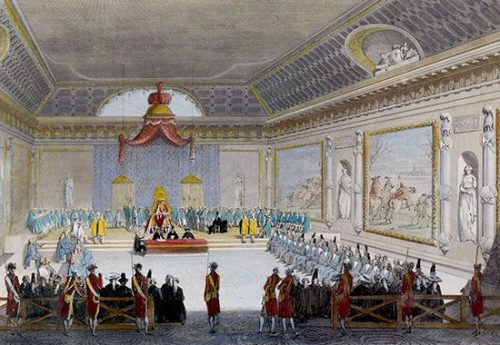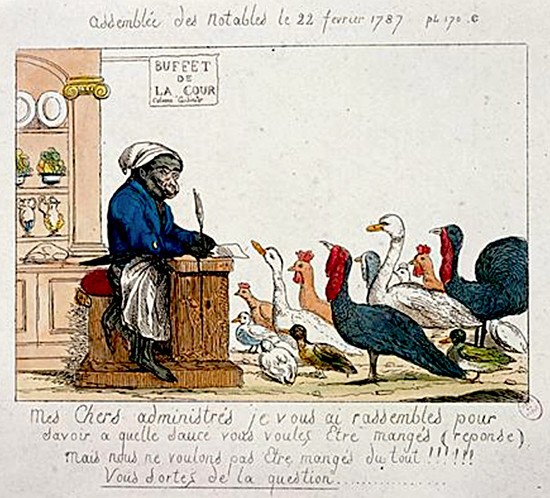
The Assembly of Notables was a significant but seldom used institution in the Ancien Regime. Comprised of around 12 dozen members of the aristocracy and high clergy, the Assembly of Notables was effectively an advisory council for the king, usually summoned in a time of crisis. It was called twice in the 1780s to support financial reforms proposed by royal ministers but both times, refused to do so.
Background
By the beginning of 1787 France’s fiscal crisis – the product of extravagant spending, insufficient revenue and mounting debt – had pushed the nation to the brink of bankruptcy. Louis XVI‘s ministers had attempted to push through urgent reforms but were thwarted by opposition from the parlements.
On the advice of his financial chief Charles-Alexandre de Calonne, the king decided to muster support by summoning an ancient institution, the Assembly of Notables. Two of these assemblies were convened in the years prior to the revolution: the first in February 1787, the second in November 1788.
Like the Estates General, the Assembly of Notables had no constitutional authority – but Calonne gambled on the Notables supporting his fiscal reforms, an outcome that would give him the upper hand over the parlements. It was a gamble that failed because the Notables also rejected Calonne’s reforms.
Calonne’s answer
Calonne’s solution to the fiscal crisis was more pragmatic than others and went straight to the heart of France’s problems. He proposed significant cuts to government expenditure, removal of some trade restrictions to free up commerce and the standardisation of indirect taxes like the gabelle.
More significantly, Calonne sought to limit the taxation privileges of the First and Second Estates. He proposed a new tax on land, to be levied on landowners based on the value of their holdings. This land tax would apply to all French citizens, regardless of class or privilege.
Needless to say, Calonne’s proposed reforms were popular with most of the Third Estate but were rejected by the church, the nobility and many wealthy bourgeoisie.
“As assembly of notables was an expanded version of the king’s council. Several times each year, whenever the king needed to cast a wider net in search of information… he would enlarge his council with personalities chosen… for their ‘zeal’ and their ‘devotion’, their ‘fidelity’ to the sovereign… Such an assembly was not an abbreviated version of the Estates General.”
Roland Mousnier, historian
An ancient institution
Recognising the parlements would not support his proposed changes, Calonne advised the king to convoke an Assembly of Notables. Like the Estates General, the Assembly of Notables was an ancient but seldom used institution. It was a council of high-ranking nobles and clergymen summoned at the king’s pleasure, usually in a time of crisis or uncertainty.
The function of the Assembly of Notables was to provide ideas and advice to the crown. Only four had been summoned in the previous 200 years, the most recent in 1626.
The Notables who gathered at Versailles in February 1787 contained 144 men, only two of whom were not nobles or higher clergymen. Among their number were 36 influential nobles, 14 bishops or archbishops and seven ‘Princes of the Blood’, as well as magistrates from the parlements, provincial deputies and the mayors of city governments.

Calonne rebuffed
Unsurprisingly, the Notables did not respond well to Calonne’s reform package. There was some in principle agreement about the need for structural reform, but the Notables believed that any major changes – particularly changes that affected the privileges and power base of the Three Estates – must be considered and approved by an Estates General.
Calonne’s prickly relationship with members of the Assembly of Notables did not help the situation. When it became clear the Notables would not endorse his proposals, Calonne sought to rally public support by publishing information about the fiscal crisis and his attempts to resolve it.
The information released by Calonne exposed the urgent need for debt relief and tax reform: an empty treasury and an annual deficit of 110 million livres in 1786. This also infuriated both the Notables and the king, who dismissed Calonne on April 7th.
Brienne tries and fails
Louis XVI replaced Calonne with Étienne Loménie de Brienne, the canny Bishop of Toulouse.
Brienne seemed better placed to push through ambitious and unpopular fiscal reforms. He was more measured in his speech and had fewer detractors than Calonne. He was himself a member of the Assembly of Notables so had been party to their deliberations. Brienne was also a favourite of Marie Antoinette, which gave him some influence in the royal court.
After consideration, Brienne presented the Notables with a reform package that was not greatly different from Calonne’s. Brienne suggested a land tax on the privileged orders and called for increased taxation contributions from the church. He was able to persuade the parlements to register many of his minor reforms, but neither the parlements or the Notables would endorse a new land tax or any changes to noble and ecclesiastical privilege.
The second assembly
A second convocation of the Assembly of Notables was ordered by the king in November 1788. This assembly was summoned shortly after the calling of the Estates General for May 1789.
This time, the king sought the Notables’ advice on political procedure rather than taxation. He asked the Notables for guidance on how the Estates General should be selected, compiled and organised, how the proceedings should be conducted and, most importantly, whether it should vote by head or order.
Their answer was straightforward: the Estates General should use the same procedures employed at its previous sitting in 1614. Each of the Three Estates should meet separately and each of the Estates should vote together, by order, rather than allowing deputies to vote individually.

A wave of propaganda
This use of ancient procedure outraged members of the Third Estate, who considered voting by order as a means of asserting privilege. If the Estates voted by order then the First and Second Estates would always vote together and the Third Estate would always lose.
News of the Notables’ ruling reached the people in late November 1788, around the time the king had relaxed restrictions on the press, allowing greater freedom of speech in publications and pamphlets. This gave rise to a flood of political literature about voting procedures at the Estates General and the urgent need for political and fiscal reform.
Some of this literature was moderate and thoughtful, some of it was radical or obscene. A few pieces, like Emmanuel Sieyès’ What is the Third Estate?, had a major influence on the political attitudes of France’s common class.
The Second Estate headed into the Estates General hopeful of asserting their political influence, however, they did not reckon on the determination of the Third Estate. The ‘aristocratic revolution’ that forced the convocation of the Estates General was about to give way to a ‘bourgeois revolution’ that would conceive a national assembly.

1. The Assembly of Notables, a council containing 144-147 influential nobles and clergymen, met twice in the 1780s after being summoned by the king on the advice of his ministers.
2. The first Assembly of Notables met at Versailles between February and May 1788. It was summoned on the advice of finance minister Calonne, who hoped to gain endorsement for his fiscal and taxation reforms.
3. Comprised of members of the First and Second Estates who were hostile to Calonne and his methods, this Assembly of Notables rejected the proposed reforms. Calonne was dismissed by the king soon after.
4. Calonne’s replacement, Brienne, placed a similar set of reforms before the Assembly of Notables and parlements. He was able to push through some reforms, however, a land tax with no exemptions was blocked.
5. The second Assembly of Notables, summoned in November 1788, ruled that the Estates General should use the same voting procedures (voting by order) used by the previous Estates General in 1614. This decision was unpopular with the Third Estate and generated a great deal of political rhetoric and literature.
Citation information
Title: ‘The Assembly of Notables’
Authors: Jennifer Llewellyn, Steve Thompson
Publisher: Alpha History
URL: https://alphahistory.com/frenchrevolution/assembly-of-notables/
Date published: September 18, 2019
Date updated: November 8, 2023
Date accessed: July 27, 2024
Copyright: The content on this page is © Alpha History. It may not be republished without our express permission. For more information on usage, please refer to our Terms of Use.
